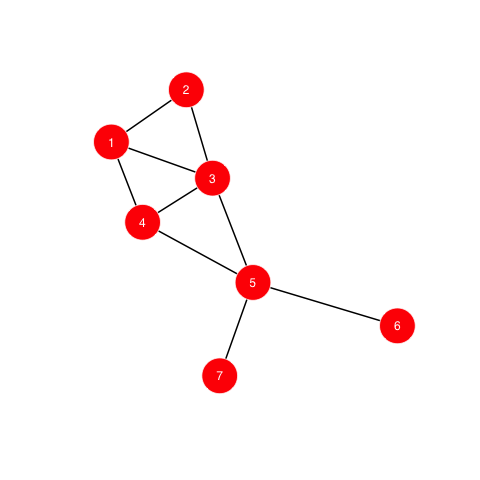Graphs basics
1. The basics
Some concepts related to graphs:
- path
- cycle
- self loop
- directed graph
- simple digraph
- non-directed graph
- unconnected graph
- strongly connected graph
- Directed acyclic graph
- Ways to represent a graph
- articulation points
- Edges
- Vertex
- spanning trees
The definition of a graph:
\(G=(E,V)\)
So a graph is a set of pairs of edges and vertices. Time complexity for traversing a graph depends on the method you use. In this case it is O(n2) because we are representing the graph on a matrix. If we would use a linked list to represent it, it would take O(n).
2. traversing a non cyclic graph with bfs
- Visiting Visiting in this case means print the value.
- Exploring This means, visit all the adjacent nodes.
Below we have a simple undirected graph with its adjacent matrix table representation:

| 0 | 1 | 2 | 3 | 4 | 5 | 6 | 7 | |
| 0 | 0 | 0 | 0 | 0 | 0 | 0 | 0 | 0 |
| 1 | 0 | 0 | 1 | 1 | 1 | 0 | 0 | 0 |
| 2 | 0 | 1 | 0 | 1 | 0 | 0 | 0 | 0 |
| 3 | 0 | 1 | 1 | 0 | 1 | 1 | 0 | 0 |
| 4 | 0 | 1 | 0 | 1 | 0 | 1 | 0 | 0 |
| 5 | 0 | 0 | 0 | 1 | 1 | 0 | 1 | 1 |
| 6 | 0 | 0 | 0 | 0 | 0 | 1 | 0 | 0 |
| 7 | 0 | 0 | 0 | 0 | 0 | 1 | 0 | 0 |
#include "stdio.h" #include "queue" #include "stdlib.h" #define N 8 using namespace std; void bfs(int firstElement); int main(int argc, char *argv[]) { printf("%s\n", "bfs with node: "); for (int i = 1; i < N; ++i) { printf("%d -> ", i); bfs(i); printf("\n"); } return 0; } void bfs(int firstElement) { int * visited = (int *) malloc(sizeof(int) * N); queue<int> q; // initialize visited array for (int i = 0; i < N; i++) visited[i] = 0; // visit printf("%d ", firstElement); // mark as visited visited[firstElement] = 1; // push to the queue q.push(firstElement); // repeat above process while (!q.empty()) { int r = q.front(); q.pop(); for (int c = 1; c < N; c++) if (gam[r][c] == 1 && visited[c] == 0) { printf("%d ", c); q.push(c); visited[c] = 1; } } free(visited); } // Note: gam is the graph-adjacent-matrix // the variable is loaded from the table displayed above
bfs with node: 1 -> 1 2 3 4 5 6 7 2 -> 2 1 3 4 5 6 7 3 -> 3 1 2 4 5 6 7 4 -> 4 1 3 5 2 6 7 5 -> 5 3 4 6 7 1 2 6 -> 6 5 3 4 7 1 2 7 -> 7 5 3 4 6 1 2
3. DONE traversing non cyclic graph with dfs
#include <cstdio> #include<stdio.h> #include "stdlib.h" #include "stack" #define N 8 void dfs(int firstNode); void recursive_dfs(int firstNode); int *visited_nodes = (int *)malloc(sizeof(int) * N); void clear_visited_nodes_array(void); int main(int argc, char *argv[]) { // initialize global array for (int i = 0; i < N; ++i) visited_nodes[i] = 0; for (int i = 1; i < N; ++i) { printf("dfs for node: %d -> ", i); recursive_dfs(i); printf("\n"); clear_visited_nodes_array(); } return 0; } void clear_visited_nodes_array() { for (int i = 0; i < N; ++i) visited_nodes[i] = 0; } void dfs(int firstElement) { // visit // explore int * visited = (int *) malloc(sizeof(int) * N); for (int i = 0; i < N; ++i) visited[i] = 0; std::stack<int> stack; // exploring stack.push(firstElement); while (!stack.empty()) { int e = stack.top(); stack.pop(); if (visited[e]) continue; printf("%d ", e); visited[e] = 1; for (int c = 1; c < N; c++) if (gam[e][c] == 1) stack.push(c); } } void recursive_dfs(int node) { if (visited_nodes[node] == 0) { printf("%d ", node); visited_nodes[node] = 1; for (int i = 1; i < N; ++i) if (gam[node][i] == 1 && visited_nodes[i] == 0) recursive_dfs(i); } }
dfs for node: 1 -> 1 2 3 4 5 6 7 dfs for node: 2 -> 2 1 3 4 5 6 7 dfs for node: 3 -> 3 1 2 4 5 6 7 dfs for node: 4 -> 4 1 2 3 5 6 7 dfs for node: 5 -> 5 3 1 2 4 6 7 dfs for node: 6 -> 6 5 3 1 2 4 7 dfs for node: 7 -> 7 5 3 1 2 4 6
4. Spanning trees
5. References
Some useful links that I used to build this entry.